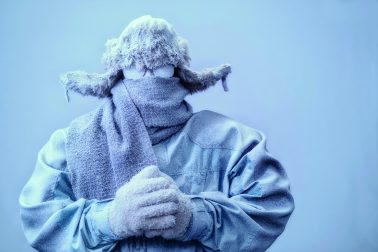Conquer the Cold: Correct PPE
 Recent extreme cold weather events have emphasised the importance of dressing appropriately for adverse weather conditions. This is particularly true if you are preparing yourself for outdoor work as weather patterns can be unpredictable, leaving you at risk. Preparing yourself for outdoor work means not just choosing the correct PPE for the job, but also wearing it appropriately. In this regard, effectively retaining heat when working in cold conditions is not just a matter of what you wear, but most importantly, how you wear it.
Recent extreme cold weather events have emphasised the importance of dressing appropriately for adverse weather conditions. This is particularly true if you are preparing yourself for outdoor work as weather patterns can be unpredictable, leaving you at risk. Preparing yourself for outdoor work means not just choosing the correct PPE for the job, but also wearing it appropriately. In this regard, effectively retaining heat when working in cold conditions is not just a matter of what you wear, but most importantly, how you wear it.
The most effective way to regulate your body heat with clothes when working outdoors is to take a layered approach. ‘Layering’ is a term used to describe a way of dressing where the emphasis is on having multiple, lighter layers rather than one thick layer. This works by trapping pockets of air between the layers which prevents heat being lost as quickly. It also allows you to better regulate your temperature as layers can be easily added or subtracted depending on how hot or cold you get.
Difficulties of layering when working outside
Maintaining the right temperature whilst working outside is particularly difficult when the job is physical. Although you might be perfectly temperate when you start working, as you exert yourself, your temperature will rise which may lead to overheating, and when you perspire it will cool quickly leaving you at risk of hypothermia.
It is also important to be mindful of keeping your extremities adequately warm when working outside as they are the first place your body draws heat from when your core temperature drops. This is problematic when working as it can significantly decrease your dexterity and mobility. Mittens are better at conserving heat as heat will transfer between fingers, however, they may be less functional. As such, it might be best to pair mittens with a thinner inner glove.
How to layer properly
When working outside, a layering system should be used. Start with a base wicking layer to remove moisture and then heavier, thicker fabrics to keep you warm. An example of an effective layering system might look something like this:
- Base Layer: The layer next to your skin should consist of synthetic underwear and an additional base layer of long underwear. Using synthetic fabrics instead of cotton allows you to wick perspiration away from your skin, preventing loss of heat.
- Mid-Layer: This should consist of thick insulating socks, synthetic trousers, a synthetic shirt, and glove liners. Try to use lighter fabrics and clothing that allows for free and easy movement.
Insulating Layer: This is a heavier layer and could consist of a thick fleece and fleece trousers to keep the heat in.
Outer layer: If particularly cold and dry a thick jacket is best, however if rain or snow is predicted a rain and wind-proof shell is recommended to protect you from the elements and to keep the heat in. - Head and Neck: It is also important to wear a scarf or other neck protector as well as a hat – 50% as body heat is lost through the head. Balaclavas and thermal helmet warmers are also available to keep your face warm.
- Feet: Wearing two layers of socks for winter working is recommended. A thin polypropylene sock underneath a thicker wool sock will keep feet warm even when wet. Sturdy, waterproof work boots are great as they can accommodate thicker socks.
Best fabrics
Synthetic fabrics are ideal as they are quick drying and less prone to becoming wet when compared to natural fabrics. They effectively wick moisture away from your body, preventing heat loss when sweat begins to cool. Fleece is good as it is moisture wicking and quick drying, whereas wool draws heat from your body.
Other top tips for outdoor working
- Eat regularly (6-8 snacks are better than 2 heavy meal)
- Avoid caffeine and alcohol, they restrict blood vessels making it harder to stay warm
- Stay hydrated by drinking plenty of fluids
- Keep an eye on colleagues for signs of hypothermia
- Try and avoid working alone when possible
